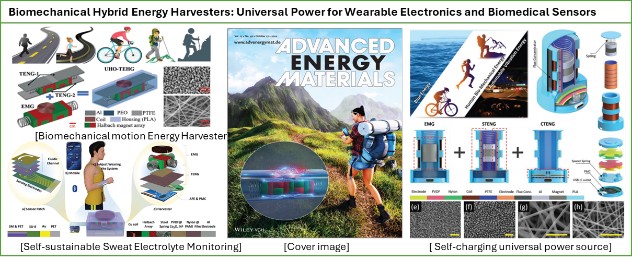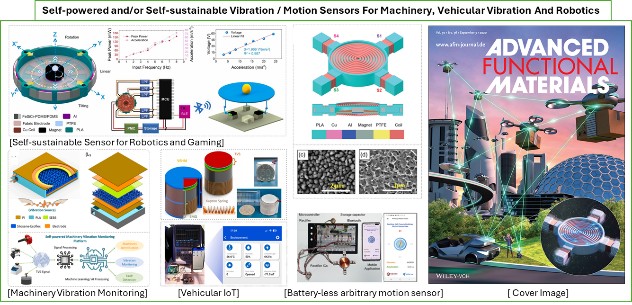Biomechanical Energy Harvesters for Wearabel IoT:
The Advanced Self-powered Electronics Research (ASER) Lab has developed a high-efficiency hybrid energy harvesting system that converts human motion into electricity—pushing the boundaries of self-powered wearable and mobile technologies. This system combines two cutting-edge innovations: the Ultrahigh-Output Triboelectric-Electromagnetic Hybrid Generator (UHO-TEHG) and the Universal Self-Chargeable Power Module (USPM).Utilizing nanofiber-enhanced triboelectric layers and magnetic flux concentrators, the UHO-TEHG delivers up to 1.02 W under low-frequency motion. The compact USPM integrates energy harvesting, storage, and USB-C output, providing 34.11 mW for powering mobile devices. These technologies enable real-time charging of wearables, smartphones, and operation of self-powered sensors during everyday activities—marking a key step toward sustainable, body-powered electronics for IoT, healthcare, and smart mobility.

Self-sustainable Outdoor Environment Monitoring IOTs:
Power-Free Solutions for Real-Time Water Quality Sensing: Researchers have unveiled two self-sustaining platforms for real-time aquatic monitoring without external power. The Smart Pool Monitoring System (SPMS) uses a brachistochrone-inspired electromagnetic generator to harvest pool water motion, powering sensors that wirelessly report pH, temperature, chloride, and conductivity. For marine environments, an ellipsoidal hybrid generator integrates triboelectric and electromagnetic systems to harvest multi-directional wave energy, delivering up to 106 mW to support onboard sensors and wireless data transmission. These innovations offer a sustainable solution for autonomous water quality and water wave monitoring across recreational and marine applications.

Flexible Self-powered Wearables for HMI and Rehablitation:
Researchers have developed a new class of self-powered triboelectric sensors that promise to revolutionize wearable electronics and human–machine interaction. Highlights include a 3D-printed toroidal sensor with high sensitivity for gesture control, a stretchable hydrogel-based strain sensor for rehabilitation and motion tracking, and a breathable sensor with advanced comfort and reliability. Additionally, a high-performance nanofibrous TENG achieves record energy output for powering small electronics and monitoring posture. These innovations combine comfort, flexibility, and functionality—paving the way for smarter, self-sustaining wearable technologies.

Self-Powered Sensors for Machinery and Vehicular Vibration :
Smart Motion Sensing—Powered by Motion Itself: The ASER Lab has introduced a suite of next-generation, self-powered motion and vibration sensing technologies designed to meet the growing demands of autonomous control systems, smart vehicles, and industrial monitoring—all without the need for external power sources. At the core of these innovations are hybrid nanogenerators that integrate triboelectric and electromagnetic mechanisms, enabling energy harvesting from diverse motion forms—linear, rotational, tilting, or arbitrary-directional. A dual-mode TENG-EMG platform features magnetic repulsion-assisted actuation for accurate real-time motion detection, while also wirelessly powering robotic control systems. For industrial applications, a macro-pillared elastomeric SP-TVS sensor delivers high sensitivity and a broad frequency range (0.01–15 kHz), enabling precise vibration monitoring, fault detection, and AI-assisted predictive maintenance across complex machinery. In automotive environments, a vehicle energy harvesting module (VEHM) combines low-stiffness springs, triboelectric sensing, and magnetic flux-enhanced coils to capture road-induced vibrations. It supports full-system wireless monitoring of indoor conditions (temperature, humidity, UV, light, etc.)—offering a scalable path toward energy-autonomous vehicles. Finally, a magnetic repulsion-driven hybrid sensor (MRSMS–HNG) demonstrates battery-free operation and arbitrary motion sensing, transmitting real-time data directly to mobile devices. Together, these technologies represent a leap forward in self-sustaining, wirelessly networked motion sensing, empowering the next generation of smart robotics, predictive maintenance, and autonomous mobility platforms.

